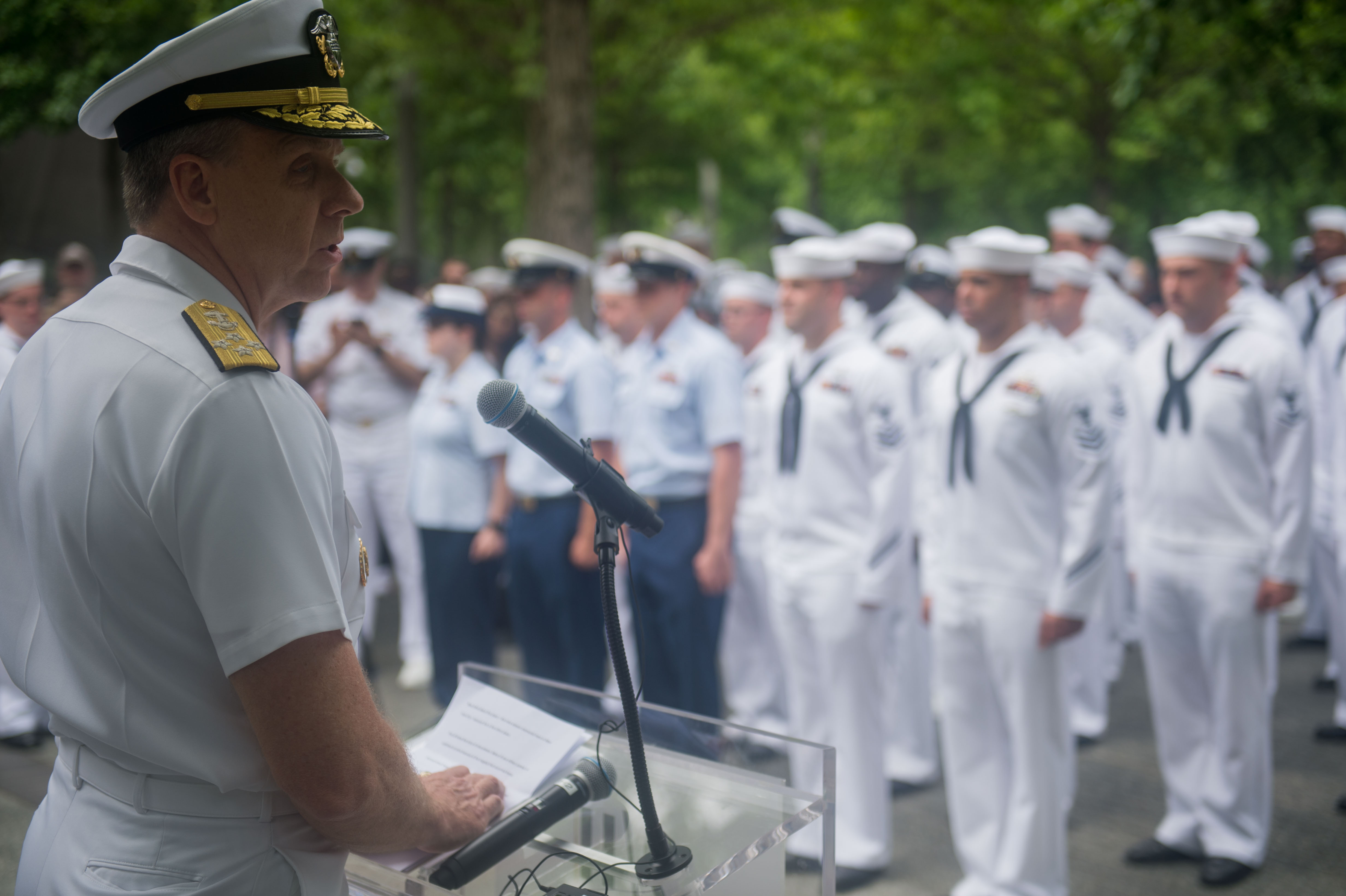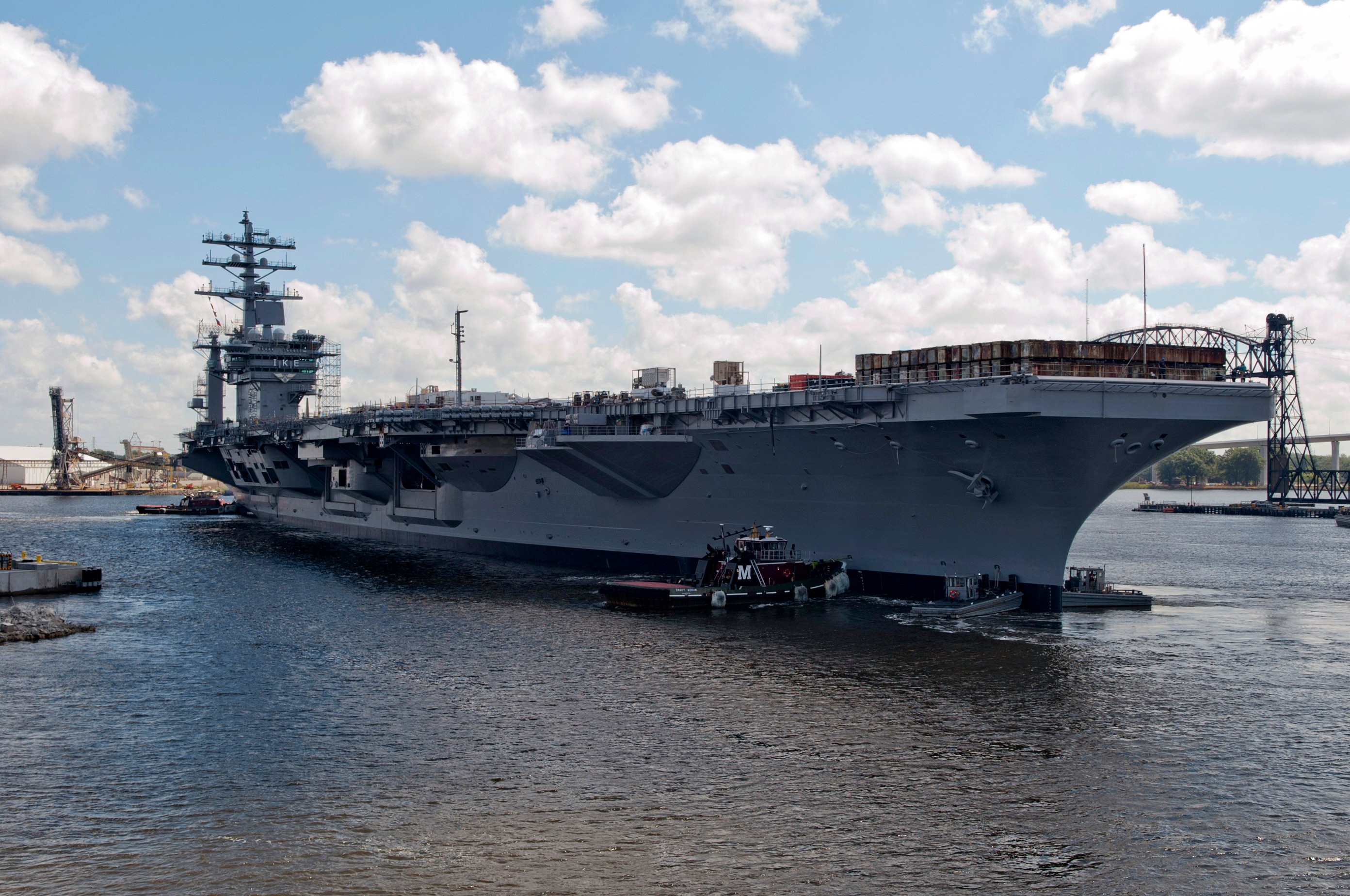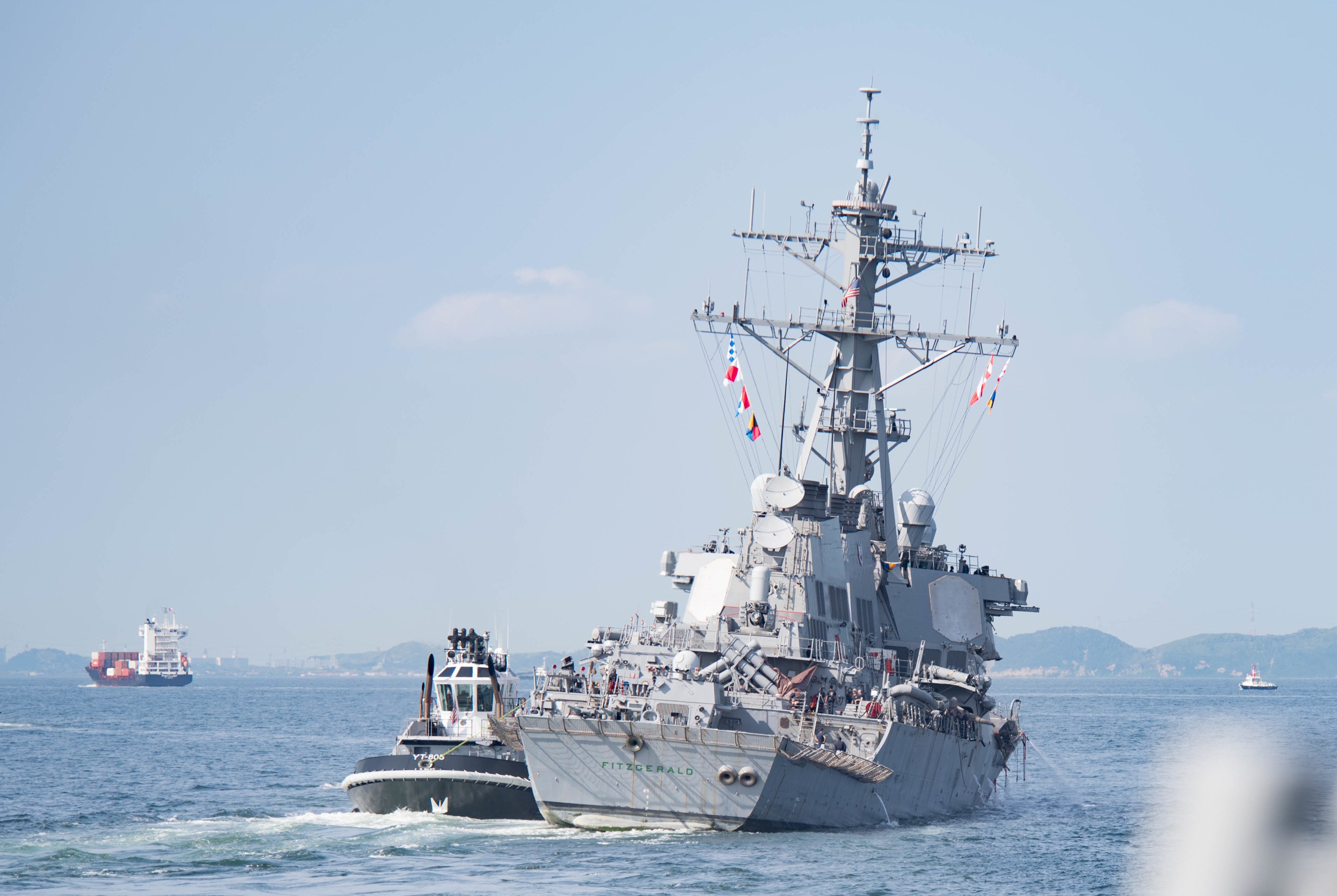
NAVAL STATION NORFOLK, Va. — The Navy is eyeing ways to balance its training, maintaining and operating needs amid high global demand for naval forces, the commander of U.S. Fleet Forces Command told surface community leaders last week following the release of the Comprehensive Review of Recent Surface Force Incidents.
And for times when that balance cannot be achieved, the service hopes to use data analytics to predict when the fleet might be in danger of committing another major mishap, getting ahead of readiness problems instead of just responding afterward.
Adm. Phil Davidson, speaking to Naval Surface Force Atlantic staff and Norfolk waterfront commanders in a Nov. 6 All Hands Call, said the Navy – and particularly its Forward Deployed Naval Forces operating out of Japan – finds itself facing a “rise in operational demand, maintenance availabilities going long, and training getting squeezed in the middle.” With sailors seeing more time between dedicated training opportunities, they may lose some good habits and fundamentals that are drilled into them during basic training events.
Davidson made clear there will never be a perfect balance of maintenance, training events and deployments, but he said the Navy must try to do better. The talk came as the surface Navy weighs its path forward after the preventable collisions of guided-missile destroyers USS Fitzgerald (DDG-62) and USS John S. McCain (DDG-56) that cost the lives of 17 sailors.
“The world gets a vote: hurricane season comes, it disrupts your maintenance,” he said.
“I impose on your training plan to get other training done, because we have a fleet to run, not just a surface force – oh, we’ve got to go do [deck landing qualifications] this week. Oh by the way, here’s some new [ballistic missile defense] stations so we’re going to start changing the deployment schedule. ... You have to accommodate all that.”
While noting the importance of inspections, certifications, assessments and visits (ICAVS), Davidson said there are currently 238 different ICAV events that can take time out of a ship’s training schedule, and he said those that are not useful ought to be cut, and those that are kept on the schedule need to ensure they send useful feedback to the ship crews.
“I don’t really see an environment where all the training is inviolate; it can’t be protected all the time. The surface force is part of the fleet, and that’s how we’re organized going forward,” he said during a question and answer session, in reference to the time taken from basic training to support qualifying aviators, training with submarines, supporting teaching and testing activities and more.
“By all means, though, as we unravel this inspection, certification, and assessment process, I would like to turn that time back to the units so that they’ve got the time … they need to get after what they need to get after.”
Asked during the about tamping down operational requirements by telling combatant commanders “no” from time to time, Davidson responded, “We do say no, every COCOM hates my guts. I have to say no a lot. There’s going to have to be a delivery of some notice out there in the Pacific, they’ve got to find a sustainable level. At the end of the day, we need a bigger Navy to accomplish all the tasks we’ve been asked to do. There are plenty of things out there we’re just not doing anymore that we’ve said no to – who’s going to [U.S. Southern Command]? Who’s spending time in the Arctic? There are a number of missions. I’d love to have more carrier, [Amphibious Ready Group] and submarine presence in [U.S. European Command] right now, we just don’t have the capacity to provide it.”
Speaking to USNI News later in the day after his All Hands Call, Davidson said the supply/demand relationship between the Navy and the combatant commanders would have to change going forward – something that is being examined in a second Navy review following this year’s string of surface navy collisions, this one led by the secretary of the Navy.

The Navy in 2014 moved to the Optimized Fleet Response Plan as a force generation model for U.S.-based carrier strike group ships. Separate models were supposed to be drawn up for amphibious ships and for forward-deployed forces, but Davidson acknowledged the challenge U.S. 7th Fleet in particular had with this task.
“All the fleets did that. 6th Fleet had an advantage because they got to go from zero, because they were just getting the ships; invent the process, invent it specifically for that combatant command. 5th Fleet did theirs a little bit – there’s two cycles, you’ve got the 24-month cycle running on the PCs (patrol coastal ships) and the 36-month cycle running on the MCMs (mine countermeasures ships),” Davidson said.
“7th Fleet affirmed their patrol cycle from back in the day,” rather than draw up a new force generation model, the admiral continued.
“They’re revisiting it as part of [U.S. Pacific Fleet Commander Adm. Scott] Swift’s tasking right away, and we affirmed that in the comprehensive review. So they have to now look at the new demand – and they’ve gotten a lot of new operational demand over the last two years, even in the last year – they have to look at how their maintenance construct has changed a little bit because now they’ve got 11 ships in Yokosuka instead of nine, and then they have to look at the training and certifications that are required and figure out what that patrol cycle is going forward. … That’ll be coming out in the next couple of months. Adm. Swift is going to be the biggest vote in the thing, but OPNAV and the [chief of naval operations] are going to have to look at it, because it’s going to define, to a certain extent, the relationship – the supply relationship the Navy is going to provide and the demand relationship that [U.S. Pacific Command] and others are putting on the force. So I think it’ll have to be looked at Navy-wide.”
Davidson made clear to USNI News and at the All Hands Call that the FDNF forces in 7th Fleet “didn’t get in this situation through expediency. They’ve been busting their hump out there trying to meet the mission.”
While acknowledging room to improve how U.S.-based and forward-deployed forces balance conflicting training, maintenance and operational deployment needs, Davidson also said even the best designed plan would be thrown off by natural disasters, global contingencies that call for changes to deployment schedules, and more. As something of a tripwire, Davidson in his All Hands Call described a data collection and analysis effort that might “help us get on the left side of mishaps so that we can give you predictive things that might be issues coming in the future and preventive safety guidance, as opposed to post-mishap guidance.”
The admiral elaborated during his interview with USNI News, noting that “when you start to unpack a pattern of incidents – or not even a pattern of incidents, but you understand several incidents and what was the run-up to them in terms of schedule, what conditions existed and all that other kind of stuff, and really begin to understand near-mishaps and what you might be missing out on, I think you can become, with the right data analytics and analysts, you can get on the front-side of the predictive piece. When the submarine forces went through their several accidents last decade – kind of [2001] to [2010] – they had several kind of similar events where they went after these reviews and …instead of just looking at mishaps, now they’re looking at all factors, including near-mishaps but other things that we train and inspect, and they’ve put in place the data analytics to look across the span of what they’re seeing, and now they can trend these conditions.”
For example, he said, the submarine community can see that if a particular hull had a reduced training period and then received certain grades in its pre-deployment training activities, it might be at a higher risk of a certain type of mishap. The surface community hopes to emulate that predictive analytics system for its own fleet, tracking smaller mishaps in a new near-miss database and combining that information with other records and scores to look for potential readiness problems before they occur.

Davidson said the Naval Safety Center, type commanders and fleet headquarters would be hiring additional data analysts to help understand at the ship level, the numbered fleet level and the Navy level what risks ships are facing and how that risk may be reduced.
To support this predictive analytics vision, Naval Surface Force Atlantic (SURFLANT) stood up a near-miss database in March, with Naval Surface Force Pacific following shortly after. Capt. Hung Le, director of the Commander’s Action Group at SURFLANT, told USNI News in a Nov.6 interview at the SURFLANT office that ship commanders within SURFLANT’s command are encouraged to and in some cases ordered to submit a self-critiquing report following a near-miss incident, a significant event such as loss of propulsion or electrical power, or a Class B or C mishap.
“Really the intent of the near-miss reporting process is for us to learn as a surface force from other people’s mistakes,” Le said.
Much like the submarine community’s self-critique process, commanding officers submit reports to Le’s office for review and dissemination – a redacted version of the report, without ship or personnel names included, is available on the SURFLANT SharePoint and are sent periodically by email, with a quarterly report also sent out to highlight any trends. The quarterly reports also seek to tie the incidents to the six watchstanding principles, and reminds COs about the importance of risk management and the planning, briefing, executing and debriefing (PBED) process.
“The ships say that it’s a useful process for them to go through and identify what went wrong and to ask the deeper questions of why, why did this happen,” Le said.
“It’s useful because it provides examples for training on their own ships, to say, hey, we don’t know exactly which ship, but say a cruiser that had this issue, and then they go over with their teams in training sessions, so it’s a good training tool really to say, hey, where could we fall into the same trap here and do we have processes in place so we’re not going to run into this?”
He noted that nearly all the reports submitted so far have been attributed to “personnel” as an apparent cause, rather than the design of the system, a material failure or a flawed procedure.
“In just about every single one, it’s personnel. People make errors. There’s only been a couple that I’ve had that I’ve seen where it says material, where there’s a material failure of a valve or something. So more often than not it’s folks who aren’t applying correctly the six watchstanding principles,” Le said.
“They’re only going to get better as a force if we share lessons learned with one another.”





